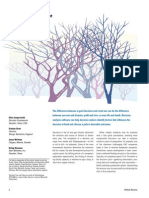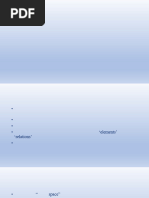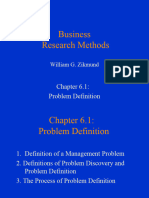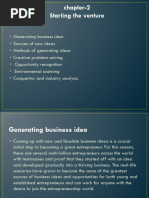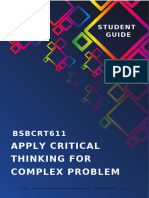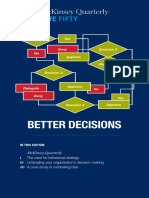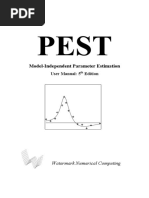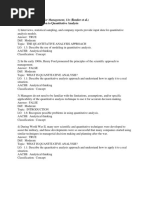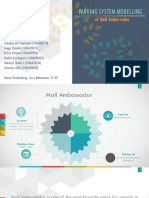Management Science: Chapter 2 Powerpoint
Management Science: Chapter 2 Powerpoint
Uploaded by
Myght SolidariosCopyright:
Available Formats
Management Science: Chapter 2 Powerpoint
Management Science: Chapter 2 Powerpoint
Uploaded by
Myght SolidariosOriginal Title
Copyright
Available Formats
Share this document
Did you find this document useful?
Is this content inappropriate?
Copyright:
Available Formats
Management Science: Chapter 2 Powerpoint
Management Science: Chapter 2 Powerpoint
Uploaded by
Myght SolidariosCopyright:
Available Formats
STEPHEN G.
POWELL
KENNETH R. BAKER
MANAGEMENT CHAPTER 2 POWERPOINT
SCIENCE MODELING IN A PROBLEM-SOLVING FRAMEWORK
The Art of Modeling with Spreadsheets
Compatible with Analytic Solver Platform
FOURTH EDITION
MODELERS’ ROLES IN THE PROBLEM-SOLVING PROCESS
• End user
– Identifies problems, develops model, uses model, and
implements results
– Often the modeler
• Team member
– Communication skills critical
– Whole team must understand model and assumptions
• Independent consultant
– Model is for a client
– Model must be consistent with client’s goals
Chapter 2 Copyright © 2013 John Wiley & Sons, Inc. 2
KEY TERMS: “PROBLEM” VERSUS A “MESS”
• A problem is a well-defined situation that is capable of
resolution.
• A mess is a morass of unsettling symptoms, causes, data,
pressures, shortfalls, opportunities, etc.
• Identifying a problem in the mess is the first step in the
creative problem solving process.
Chapter 2 Copyright © 2013 John Wiley & Sons, Inc. 3
PROBLEM STATEMENTS
• A statement in the form “In what ways might…?”
– Focuses on defining the problem to be solved
– Example: “In what ways might we increase revenues to
keep pace with costs?”
• Solutions will differ based on the problem statement, so:
– Pay close attention to the problem definition.
– Take any problem definition as tentative.
– Prepare to alter the definition if evidence suggests a
different statement would be more effective.
Chapter 2 Copyright © 2013 John Wiley & Sons, Inc. 4
CHARACTERISTICS OF WELL-STRUCTURED PROBLEMS
• The objectives of the analysis are clear.
• The assumptions that must be made are obvious.
• All the necessary data are readily available.
• The logical structure behind the analysis is well
understood.
• Example: Algebra problems are typically well- structured
problems.
Chapter 2 Copyright © 2013 John Wiley & Sons, Inc. 5
ILL-STRUCTURED PROBLEMS
• Objectives, assumptions, data, and structure of the
problem are all unclear.
• Examples:
– Should the Red Cross institute a policy of paying for blood
donations?
– Should Boeing’s next major commercial airliner be a small
supersonic jet or a slower jumbo jet?
– Should an advertiser spend more money on the creative
aspects of an ad campaign or on the delivery of the ad?
– How much should a mid-career executive save out of
current income toward retirement?
• Require exploration more than solutions.
Chapter 2 Copyright © 2013 John Wiley & Sons, Inc. 6
EXPLORATION
• With an inquiring mind and a spirit of discovery,
exploration involves:
– formulating hypotheses
– making assumptions
– building simple models
– deriving tentative conclusions
• It often reveals aspects of the problem that are not
obvious at first glance.
Chapter 2 Copyright © 2013 John Wiley & Sons, Inc. 7
DIVERGENT AND CONVERGENT THINKING
• Divergent thinking
– Thinking in different directions
– Searching for a variety of answers to questions that may
have many right answers
– Brainstorming
• Convergent thinking
– Directed toward achieving a goal or single solution
– Involves trying to find the one best answer
– Emphasis shifts from idea generation to evaluation
• Decision makers need to be clear as to which they use at
a given time, and balance the two.
Chapter 2 Copyright © 2013 John Wiley & Sons, Inc. 8
THE SIX-STAGE PROBLEM-SOLVING PROCESS
1. Exploring the mess
Divergent phase
Search the mess for problems and opportunities.
Convergent phase
Accept a challenge and undertake systematic efforts to respond to it.
2. Searching for information
Divergent phase
Gather data, impressions, feelings, observations; examine the situation from many
different viewpoints.
Convergent phase
Identify the most important information.
3. Identifying a problem
Divergent phase
Generate many different potential problem statements.
Convergent phase
Choose a working problem statement.
Chapter 2 Copyright © 2013 John Wiley & Sons, Inc. 9
THE SIX-STAGE PROBLEM-SOLVING PROCESS (CONT’D)
4. Searching for solutions
Divergent phase
Develop many different alternatives and possibilities for solutions.
Convergent phase
Select one or a few ideas that seem most promising.
5. Evaluating solutions
Divergent phase
Formulate criteria for reviewing and evaluating ideas.
Convergent phase
Select the most important criteria; use them to evaluate, strengthen, and refine ideas.
6. Implementing a solution
Divergent phase
Consider possible sources of assistance and resistance to proposed solution. Identify
implementation steps and required resources.
Convergent phase
Prepare the most promising solution for implementation.
Chapter 2 Copyright © 2013 John Wiley & Sons, Inc. 10
EXAMPLE: INVIVO DIAGNOSTICS
• A $300M pharmaceutical company built on the strength
of a single product that accounts for over 75% of
revenues.
• In 18 months, the patent for this product will expire.
• The CEO wants to explore ways to plug the expected
$100-$200M revenue gap as revenues from this product
decline.
Chapter 2 Copyright © 2013 John Wiley & Sons, Inc. 11
1. EXPLORING THE MESS
• What problems or opportunities do we face?
• Where is there a gap between the current situation and
the desired one?
• What are the stated and unstated goals?
• This stage is complete when we have:
– A description of the situation
– Identified (not gathered) key facts and data
Chapter 2 Copyright © 2013 John Wiley & Sons, Inc. 12
2. SEARCHING FOR INFORMATION
• What are the symptoms and causes?
• What measures of effectiveness seem appropriate?
• What actions are available?
• This stage is complete when we have:
– Found and organized relevant data
– Made initial hypotheses about problem causes and
solutions
Chapter 2 Copyright © 2013 John Wiley & Sons, Inc. 13
3. IDENTIFYING A PROBLEM
• Which is the most important problem?
• Is this problem like others we have dealt with?
• What are the consequences of a broad versus narrow
problem statement?
• This stage is complete when we have produced a
working problem statement.
Chapter 2 Copyright © 2013 John Wiley & Sons, Inc. 14
4. SEARCHING FOR SOLUTIONS
• What decisions are open to us?
• What solutions have been tried in similar situations?
• How are the various candidate solutions linked to
outcomes of interest?
• This stage is complete when we have produced a list of
potential solutions.
– Perhaps also a list of advantages and disadvantages
Chapter 2 Copyright © 2013 John Wiley & Sons, Inc. 15
5. EVALUATING SOLUTIONS
• How does this solution impact each of the criteria?
• What factors within our control could improve the
outcomes?
• What factors outside our control could alter the
outcomes?
• This stage is complete when we have produced a
recommended course of action along with justification.
Chapter 2 Copyright © 2013 John Wiley & Sons, Inc. 16
6. IMPLEMENTING A SOLUTION
• What are the barriers to successful implementation?
• Where will there be support and motivation, or
resistance and conflict?
• Are the resources available for successful
implementation?
• This stage is complete when we have produced an
implementation plan and begun execution.
Chapter 2 Copyright © 2013 John Wiley & Sons, Inc. 17
MENTAL MODELS (INFORMAL MODELING)
• Help us to relate cause and effect
– But often in a simplified, incomplete way
• Help us determine what is feasible
– But may be limited by personal experiences
• Are influenced by our preferences for certain outcomes
• Are useful but can be limiting
• Problem solvers construct quick, informal mental models
at many different points in the process.
Chapter 2 Copyright © 2013 John Wiley & Sons, Inc. 18
FORMAL MODELS
• Provide the same kind of information as mental models
– Link causes to effects, aid in evaluating solutions
• Require a set of potential solutions and criteria to
compare solutions to be identified
• More costly and time consuming to build than mental
models
• Make assumptions, logic, and preferences explicit and
open to debate
Chapter 2 Copyright © 2013 John Wiley & Sons, Inc. 19
INFLUENCE CHARTS
• A simple diagram to show outputs and how they are
calculated from inputs
• Tool of choice for complex, unstructured problems
• Identifies main elements of a model
• Delineates the boundaries of a model
• Recommended for early stages of any problem
formulation task
• Flexible, support frequent revision
Chapter 2 Copyright © 2013 John Wiley & Sons, Inc. 20
BUILDING AN INFLUENCE CHART
• Built from right to left
• Conventions on types of variables
– Outputs – hexagons
– Decisions – boxes
– Inputs – triangles
– Other variables – circles
– Random variables – double circles
– See Figure 2.3
Figure 2.3
Chapter 2 Copyright © 2013 John Wiley & Sons, Inc. 21
INFLUENCE CHART PRINCIPLES
• Start with outcome measure
• Decompose outcome measure into independent
variables that directly determine it
• Repeat decomposition for each variable in turn
• Identify input data and decisions as they arise
• Ensure each variable appears only once
• Highlight special types of elements with consistent
symbols
Chapter 2 Copyright © 2013 John Wiley & Sons, Inc. 22
EXAMPLE 1: A PRICING DECISION
• “Determine the price we should set for our product so as
to generate the highest possible profit this coming year.”
• See Figures 2.2a – 2.2f
Chapter 2 Copyright © 2013 John Wiley & Sons, Inc. 23
EXAMPLE 1: A PRICING DECISION
Chapter 2 Copyright © 2013 John Wiley & Sons, Inc. 24
EXAMPLE 1: A PRICING DECISION
Chapter 2 Copyright © 2013 John Wiley & Sons, Inc. 25
EXAMPLE 1: A PRICING DECISION
Chapter 2 Copyright © 2013 John Wiley & Sons, Inc. 26
EXAMPLE 2: THE SS KUNIANG1
• In the early 1980s, New England Electric System (NEES)
was deciding how much to bid for the salvage rights to a
grounded ship, the SS Kuniang. If the bid were
successful, the ship could be repaired and outfitted to
haul coal for the company’s power-generation stations.
But the value of doing so depended on the outcome of a
U.S. Coast Guard judgment about the salvage value of
the ship.
• See Figure 2.6
1
D. E. Bell, “Bidding for the S.S. Kuniang,” Interfaces 14 (1984): 17–23.
Chapter 2 Copyright © 2013 John Wiley & Sons, Inc. 27
EXAMPLE 3: AUTOMOBILE LEASING
• The primary challenge for companies offering a closed-
end lease is to select the residual value of the vehicle.
• See Figure 2.7
Chapter 2 Copyright © 2013 John Wiley & Sons, Inc. 28
INFLUENCE CHARTS WRAP-UP
• The goal is to develop a problem structure—not to solve
the problem.
• There is no one correct chart.
• Charts ignore all available numerical data.
• Charts rely on modeling assumptions that should be
recorded as made.
Chapter 2 Copyright © 2013 John Wiley & Sons, Inc. 29
CRAFT SKILLS FOR MODELING
• Successful modelers draw on both technical and craft
skills
• Technical skills
– Lead to a single correct answer
– Require no creativity, learned quickly
– Example: Calculating present values
• Craft skills
– Do not lead to a single answer
– Example: Designing a prototype
Chapter 2 Copyright © 2013 John Wiley & Sons, Inc. 30
CHARACTERISTICS OF CRAFT SKILLS
• Do not lead to a single answer
• Require creativity
• Harder to define and teach
• Develop slowly over time
• Involve modeling heuristics
Chapter 2 Copyright © 2013 John Wiley & Sons, Inc. 31
MODELING HEURISTICS
• Simplify the problem
• Break the problem into modules
• Build a prototype and refine it
• Sketch graphs of key relationships
• Identify parameters and perform sensitivity analysis
• Separate the creation of ideas from their evaluation
• Work backward from the desired answer
• Focus on model structure, not data collection
Chapter 2 Copyright © 2013 John Wiley & Sons, Inc. 32
SIMPLIFY THE PROBLEM
• “Model simple, think complicated”
• Simplification
– The essence of modeling
– Increases transparency - aids with buy-in
– Requires a focus on key connections and central trade-offs
– Involves making assumptions
Chapter 2 Copyright © 2013 John Wiley & Sons, Inc. 33
BREAK THE PROBLEM INTO MODULES
• Keep components as independent as possible.
• Each component is simpler to deal with than the whole.
• Development of components provides structure to the
modeling process.
Chapter 2 Copyright © 2013 John Wiley & Sons, Inc. 34
BUILD A PROTOTYPE AND REFINE IT
• A prototype is a working model.
• It should:
– Take data and inputs from the user
– Produce key outputs in response
• A prototype:
– Will be refined later
– Is, by definition, simple
Chapter 2 Copyright © 2013 John Wiley & Sons, Inc. 35
CHARACTERISTICS OF A COMPLETED PROTOTYPE
• The problem is decomposed into modules.
• We have built a simple model for each module.
• The modules work together to produce results.
• We have provided a tentative answer to the client’s
major questions.
Chapter 2 Copyright © 2013 John Wiley & Sons, Inc. 36
PROTOTYPES
• Keep the entire problem in the mind of the modeler
• Provide a roadmap for future work
• Support sensitivity analysis
– Where would my model benefit most from additional
work?
Chapter 2 Copyright © 2013 John Wiley & Sons, Inc. 37
SKETCH GRAPHS OF KEY RELATIONSHIPS
• Graphs express relationships visually
– Not mathematically or verbally
• Allows for looking at a problem from different
viewpoints
• Externalizes the analysis
– Moves it from the mind to an external artifact (the graph)
Chapter 2 Copyright © 2013 John Wiley & Sons, Inc. 38
Decisions
Outcomes
MODEL
VISUALIZATION OF THE MODELING PROCESS
Chapter 2 Copyright © 2013 John Wiley & Sons, Inc. 39
USEFUL FUNCTIONS FOR MODELING
Chapter 2 Copyright © 2013 John Wiley & Sons, Inc. 40
IDENTIFY PARAMETERS AND PERFORM SENSITIVITY
ANALYSIS
Price1 and Price2 below represent a family of relations.
o Price1 = a – b*(Quantity)
o Price2 = a*(Quantity)b (b<1)
a and b are the parameters of these models.
Sensitivity analysis
o Determines plausible ranges for the parameters
o Tests the impact of parameter values on model outputs
Parameterization builds links between our rational
knowledge and our intuition.
Chapter 2 Copyright © 2013 John Wiley & Sons, Inc. 41
SEPARATE THE CREATION OF IDEAS FROM THEIR
EVALUATION
• Many modelers prefer judging ideas over generating
them.
• To “quiet the critical voice”:
– Separate periods of divergent and convergent thinking.
– Initiate a brainstorming session; remind participants not to
criticize ideas of others.
– Realize that mistakes and blind alleys are part of the
modeling process.
Chapter 2 Copyright © 2013 John Wiley & Sons, Inc. 42
WORK BACKWARD FROM THE DESIRED ANSWER
• Start with the form the answer will take.
• Work backward to select model and analysis to generate
the chosen result.
• The “PowerPoint heuristic”
– What should be on one summary slide that contains the
essential message (e.g., a number, a table, a chart)?
Chapter 2 Copyright © 2013 John Wiley & Sons, Inc. 43
FOCUS ON MODEL STRUCTURE, NOT ON DATA COLLECTION
• Novice modelers spend a high proportion of time on
data.
• Expert modelers spend most of their time on model
structure.
Chapter 2 Copyright © 2013 John Wiley & Sons, Inc. 44
MISTAKEN BELIEFS OF NOVICE MODELERS
• The available data is the information needed in the
modeling process.
• Obtaining data moves the process forward.
• More data improves the quality of the final
recommendations.
Chapter 2 Copyright © 2013 John Wiley & Sons, Inc. 45
COMMON SOURCES OF BIASES AND ERRORS IN EMPIRICAL
DATA
• Sampling error
• Differences in purpose
• Masking
• Inappropriateness
• Definitional differences
Chapter 2 Copyright © 2013 John Wiley & Sons, Inc. 46
EXPERT MODELERS’ ATTITUDES TOWARDS DATA
• Treat data skeptically
• Realize that even good data may not be relevant for the
model
• Realize that data collection can be distracting and
limiting
• Build the model structure first and then use data to
refine it
Chapter 2 Copyright © 2013 John Wiley & Sons, Inc. 47
SUMMARY
• Effective modeling takes place within a larger problem
solving process.
• Problem-solving process:
– Exploring the mess
– Searching for information
– Defining the problem
– Searching for solutions
– Evaluating solutions
– Implementing the solution
Chapter 2 Copyright © 2013 John Wiley & Sons, Inc. 48
SUMMARY (CONT’D)
• Mental modeling is an essential tool in problem solving.
• Formal models provide the same kind of benefits as
mental models.
• Influence charts offer the modeler a bridge between an
ill-structured problem and a formal model.
Chapter 2 Copyright © 2013 John Wiley & Sons, Inc. 49
SUMMARY (CONT’D)
• Modeling heuristics are rules of thumb that help in the
design and use of models.
– Simplify the problem.
– Break the problem into modules.
– Build a prototype and refine it.
– Sketch graphs of key relationships.
– Identify parameters and perform sensitivity analysis.
– Separate the creation of ideas from their evaluation.
– Work backward from the desired answer.
– Focus on model structure, not on data collection.
Chapter 2 Copyright © 2013 John Wiley & Sons, Inc. 50
COPYRIGHT © 2013 JOHN WILEY & SONS, INC.
All rights reserved. Reproduction or translation of
this work beyond that permitted in section 117 of the 1976
United States Copyright Act without express permission of
the copyright owner is unlawful. Request for further
information should be addressed to the Permissions
Department, John Wiley & Sons, Inc. The purchaser may
make back-up copies for his/her own use only and not for
distribution or resale. The Publisher assumes no
responsibility for errors, omissions, or damages caused by
the use of these programs or from the use of the information
herein.
You might also like
- Bain - Ace The Case PDFDocument6 pagesBain - Ace The Case PDFLuis ReyesNo ratings yet
- How To Ace The Case Interview by BainDocument6 pagesHow To Ace The Case Interview by Bainshruthi1105No ratings yet
- Winning Decisions (Review and Analysis of Russo and Schoemaker's Book)From EverandWinning Decisions (Review and Analysis of Russo and Schoemaker's Book)No ratings yet
- Model Steam Turbine Method For Evaluating HRSG PerformanceDocument7 pagesModel Steam Turbine Method For Evaluating HRSG PerformanceJung Kyung WooNo ratings yet
- Making Decisions in The Oil and Gas Industry - CoopersmithDocument8 pagesMaking Decisions in The Oil and Gas Industry - CoopersmithSuta Vijaya100% (1)
- 9 Bus System DataDocument16 pages9 Bus System DataKiran Mula40% (5)
- Charles G. Petersen, Gerald Aase, 2004Document9 pagesCharles G. Petersen, Gerald Aase, 2004Rodrigo Alejandro Vergara CisternasNo ratings yet
- MAC2601 StudyGuide1of2 PDFDocument386 pagesMAC2601 StudyGuide1of2 PDFDINEO PRUDENCE NONG100% (1)
- Kuliah 6Document42 pagesKuliah 6andam ayuandaNo ratings yet
- DA Session1+2Document56 pagesDA Session1+2UsamaNo ratings yet
- Analyzing Business CasesDocument17 pagesAnalyzing Business CasesYsaiah John GallegoNo ratings yet
- Tackling Case AnalysisDocument33 pagesTackling Case AnalysisAditya VidolkarNo ratings yet
- BA-Session 1 (LO 3)Document11 pagesBA-Session 1 (LO 3)Nabil AbdurrahmanNo ratings yet
- How To Ace A Case NEWDocument6 pagesHow To Ace A Case NEWTyNo ratings yet
- Lec 2Document41 pagesLec 2w42yz9yggwNo ratings yet
- Week 1 - Introduction To The Module and Creative Decision MakingDocument25 pagesWeek 1 - Introduction To The Module and Creative Decision MakingAdrianaNo ratings yet
- Kusum PresentationDocument21 pagesKusum PresentationKusumNo ratings yet
- MTI 2023 Concept GenerationDocument66 pagesMTI 2023 Concept GenerationSafriza AhmadNo ratings yet
- 13 Problem Solving ModelsDocument28 pages13 Problem Solving ModelsZzzddd100% (2)
- Transportation Engineering.. Case AnalysisDocument112 pagesTransportation Engineering.. Case AnalysisArvin James Guitilen KidicdianNo ratings yet
- Module 2 AhDocument81 pagesModule 2 Ahadiedu5204No ratings yet
- All Ssc2 SlidesDocument374 pagesAll Ssc2 SlidesrrrrokayaaashrafNo ratings yet
- How To Ace The Case InterviewDocument6 pagesHow To Ace The Case InterviewRussell HowlandNo ratings yet
- Chapter 6 1Document35 pagesChapter 6 1madihaNo ratings yet
- Bain Ace The Case 2008Document6 pagesBain Ace The Case 2008Nabhan AhmadNo ratings yet
- Chapter 6 - MGMT 201.Document54 pagesChapter 6 - MGMT 201.Jelan Alano100% (1)
- Adm3313 M16FDocument6 pagesAdm3313 M16FDaoud HamadnehNo ratings yet
- Dispensa AGILEDocument27 pagesDispensa AGILEalexonorati99No ratings yet
- BSBCRT611 Student Guide Version 1.0Document27 pagesBSBCRT611 Student Guide Version 1.0Asad RehmanNo ratings yet
- Problem Definition and The Research ProposalDocument31 pagesProblem Definition and The Research ProposalShihabHasanNo ratings yet
- Problemsolving 190227045913Document27 pagesProblemsolving 190227045913ERSIN OZSEVENNo ratings yet
- Pink Green Colorful Vintage Aesthetic Minimalist Manhwa Interior Decor Illustration Work From Home Basic PresentationDocument43 pagesPink Green Colorful Vintage Aesthetic Minimalist Manhwa Interior Decor Illustration Work From Home Basic PresentationWayne Andrea TualaNo ratings yet
- Chapter 6 1Document35 pagesChapter 6 1Mehwish kashifNo ratings yet
- Final Effective Problem Solving and Decision Making Process V4 PDFDocument105 pagesFinal Effective Problem Solving and Decision Making Process V4 PDFAnna Bella Siriban ManalangNo ratings yet
- Session 03 Entr6012Document36 pagesSession 03 Entr6012Elkana AntonioNo ratings yet
- Problem-Solving Skills NTC PDFDocument60 pagesProblem-Solving Skills NTC PDFMunther MurjanNo ratings yet
- Strategic Change and Decision Making: Presentedby AshwinnairpimsrcollegeDocument38 pagesStrategic Change and Decision Making: Presentedby AshwinnairpimsrcollegeAshwin NairNo ratings yet
- MOD 1 NOTES (First Part)Document10 pagesMOD 1 NOTES (First Part)adhwaithvm009No ratings yet
- HRM 370 Lec-8, 9 - Solving Problems Analytically and Creatively (2 Classes)Document24 pagesHRM 370 Lec-8, 9 - Solving Problems Analytically and Creatively (2 Classes)Masudur Rahman AbirNo ratings yet
- Chapter 2 - Business Problem FramingDocument6 pagesChapter 2 - Business Problem FramingLuis Carlos PeñaNo ratings yet
- MGT523 SPR (A) DL AY21-22 RequirementDocument7 pagesMGT523 SPR (A) DL AY21-22 RequirementAbdullahNo ratings yet
- Chapter 2Document34 pagesChapter 2yashchotaliya.el21No ratings yet
- Pricing Strategy On Discounted BrandsDocument13 pagesPricing Strategy On Discounted BrandsPriyanka RaiNo ratings yet
- Ie5203 Notes 1Document14 pagesIe5203 Notes 1pintosimonneNo ratings yet
- BSBCRT611 Student GuideDocument29 pagesBSBCRT611 Student Guideruililiu1024No ratings yet
- 02 Unit II Note 1.PptxDocument50 pages02 Unit II Note 1.PptxraveendrashabuNo ratings yet
- Creative Problem Solving and Decision MakingDocument55 pagesCreative Problem Solving and Decision Makingkhairolanuarmasuan100% (4)
- MPU 2232 Chapter 2-Creativity and MotivationDocument51 pagesMPU 2232 Chapter 2-Creativity and Motivationdina azmanNo ratings yet
- TQM Chapter 7Document6 pagesTQM Chapter 7espinomarvyaNo ratings yet
- Research DesignDocument20 pagesResearch Designapi-3830923No ratings yet
- Soft SkillsDocument2 pagesSoft SkillsHajar ZarroukiNo ratings yet
- CHP 2 Making DecisionsDocument9 pagesCHP 2 Making DecisionsNour MoetassemNo ratings yet
- Module 2 - Computerized Decision SupportDocument9 pagesModule 2 - Computerized Decision Supportambika venkateshNo ratings yet
- Problem SolvingDocument14 pagesProblem Solvingkeashipadityagarg684No ratings yet
- Engineering Management Chapter 2Document3 pagesEngineering Management Chapter 2shinamaevNo ratings yet
- Problem AnalysisDocument6 pagesProblem AnalysisShania Sarcia0% (1)
- ProblemStatements Handout PDFDocument2 pagesProblemStatements Handout PDFMasuk Ur RahmanNo ratings yet
- 07.Manager as Decision MakerDocument31 pages07.Manager as Decision Makerali goharNo ratings yet
- The Complete Idiot's Mini Guide to Project Goals for Project ManagersFrom EverandThe Complete Idiot's Mini Guide to Project Goals for Project ManagersNo ratings yet
- Quantum Leap: How to Achieve Success in the Age of DisruptionFrom EverandQuantum Leap: How to Achieve Success in the Age of DisruptionNo ratings yet
- Five Fifty Decision MakingDocument37 pagesFive Fifty Decision Makinggabrielle cherylNo ratings yet
- A Z Modelling CourseDocument359 pagesA Z Modelling CourseRishabhNo ratings yet
- Lecture 7 Genetic Algorithms PDFDocument60 pagesLecture 7 Genetic Algorithms PDFSai RamNo ratings yet
- Specs2 PrelimDocument9 pagesSpecs2 PrelimA.GNo ratings yet
- Verification of A Laser Tracker With An Indexed Metrology PlatformDocument12 pagesVerification of A Laser Tracker With An Indexed Metrology PlatformMariNo ratings yet
- PEST ManualDocument336 pagesPEST ManualEnzo HurtadoNo ratings yet
- BBL 040Document11 pagesBBL 040Cindy MarianoNo ratings yet
- Developers 6.0developers Guide For Dakota 6.0Document906 pagesDevelopers 6.0developers Guide For Dakota 6.0Alexandre PereiraNo ratings yet
- Manajemen Kuantitatif - Program LinierDocument64 pagesManajemen Kuantitatif - Program LinierAlbertus AdityaNo ratings yet
- SPE-170669-MS The Use of Reservoir Simulation in Estimating ReservesDocument14 pagesSPE-170669-MS The Use of Reservoir Simulation in Estimating Reservesvladimirch86No ratings yet
- Chapter 1 Test BankDocument29 pagesChapter 1 Test Bankbienp.sabNo ratings yet
- Tolerancing in Code V: 3280 East Foothill Boulevard Pasadena, California 91107 USA (626) 795-9101 Fax (626) 795-0184Document38 pagesTolerancing in Code V: 3280 East Foothill Boulevard Pasadena, California 91107 USA (626) 795-9101 Fax (626) 795-0184zarasettNo ratings yet
- Realistic Pipe Prover Volume Uncertainty - Paul MartinDocument26 pagesRealistic Pipe Prover Volume Uncertainty - Paul MartinSim Yun YoungNo ratings yet
- Linear Programming Problem: Sensitivity AnalysisDocument67 pagesLinear Programming Problem: Sensitivity AnalysisSUVECHCHA SENGUPTANo ratings yet
- ASME B89.4.19 Performance Evaluation Tests and Geometric Misalignments in Laser Trackers VolumeDocument15 pagesASME B89.4.19 Performance Evaluation Tests and Geometric Misalignments in Laser Trackers VolumeJDNo ratings yet
- Project Risk Management - Area 8Document49 pagesProject Risk Management - Area 8Rutu BarveNo ratings yet
- Spe 169366 MSDocument20 pagesSpe 169366 MSEdgar GonzalezNo ratings yet
- 7 LP Sensitivity AnalysisDocument9 pages7 LP Sensitivity AnalysiszuluagagaNo ratings yet
- Cost - Effectiveness Analysis (CEA)Document9 pagesCost - Effectiveness Analysis (CEA)Yeliana Hani RitongaNo ratings yet
- Sensitivity AnalysisDocument65 pagesSensitivity AnalysisPrincess ElaineNo ratings yet
- Shen 2020Document14 pagesShen 2020Bamrung SungnoenNo ratings yet
- Sensobol: An R Package To Compute Variance-Based Sensitivity IndicesDocument40 pagesSensobol: An R Package To Compute Variance-Based Sensitivity Indicesajayiit2010No ratings yet
- Parking System Modelling: of Mall AmbassadorDocument51 pagesParking System Modelling: of Mall AmbassadorkenzyaNo ratings yet
- A Brief Introduction To Design of Experiments PDFDocument9 pagesA Brief Introduction To Design of Experiments PDFjonathan2788No ratings yet
- A Risk Assessment Framework Considering Uncertainty For Corrosion-Induced Natural Gas Pipeline AccidentsDocument11 pagesA Risk Assessment Framework Considering Uncertainty For Corrosion-Induced Natural Gas Pipeline AccidentsMuhammad Nur FauziNo ratings yet




